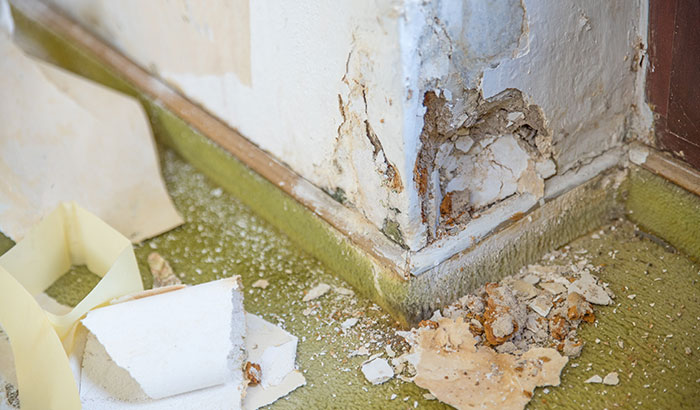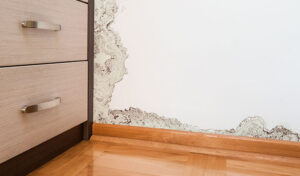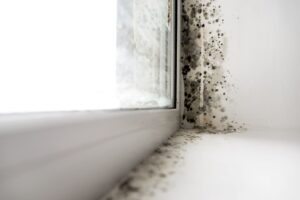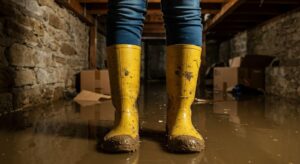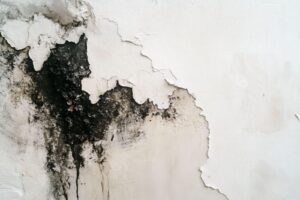Leaving water damage in your home unaddressed can lead to several issues that can be dangerous and expensive to fix. Here are some of the things that can go wrong if water damage in your home is left unaddressed:
- Mold Growth – Mold can start to grow within 24-48 hours after water damage occurs. Mold thrives in damp, dark environments and can spread rapidly throughout your home, causing serious health problems for you and your family, such as:
- Respiratory problems: Mold can irritate the lungs and cause respiratory problems such as coughing, wheezing, and shortness of breath. People with asthma or other respiratory conditions may experience more severe symptoms.
- Allergic reactions: Mold spores can trigger allergic reactions in some people, causing symptoms such as sneezing, runny nose, itchy eyes, and skin rash.
- Headaches: Exposure to mold can also cause headaches, especially if the person is sensitive to the odor of mold.
- Fatigue: Mold exposure can cause fatigue and lethargy, which can affect a person’s ability to carry out daily activities.
- Irritation of the eyes, nose, and throat: Mold exposure can cause irritation of the eyes, nose, and throat, leading to symptoms such as redness, itching, and sore throat.
- Neurological symptoms: In rare cases, exposure to certain types of mold can cause neurological symptoms such as tremors, seizures, and memory loss.
- Non-Mold Related Health Hazards – Stagnant water can attract bacteria, such as legionella, E. coli, salmonella, pseudomonas, and vibrio. It may also contain viruses, such as adenovirus, norovirus, rotavirus, hepatitis A, and enteroviruses. And that’s not all. It may contain other harmful microorganisms that can cause various health problems, including respiratory infections, skin rashes, and gastrointestinal illnesses.
- Structural Damage – Water damage can weaken the structure of your home, including the walls, floors, and ceilings. If left untreated, this can cause your home to become unstable and eventually collapse. This includes structural damage, such as:
- Wood rot: If water penetrates wooden structures, it can cause them to rot and weaken over time. This can compromise the integrity of the building’s structure and lead to costly repairs.
- Rust and corrosion: When metal structures are exposed to water for extended periods, they can begin to rust and corrode. This can weaken the metal and lead to structural damage.
- Foundation damage: Water can also seep into a building’s foundation, causing it to shift or crack. The foundation is… well… the foundation of your home. When this is damaged, it can lead to significant structural damage and potentially render the building unsafe.
- Electrical Problems – Water can damage electrical systems and appliances, leading to:
- Short circuits: When water comes into contact with electrical outlets, switches, or appliances, it can cause short circuits. This happens when water creates a low resistance path for electrical current to flow, which can result in overheating, sparks, and electrical fires.
- Corrosion: Water can cause corrosion to electrical components, particularly if it contains salts, minerals, or other contaminants. Corrosion can lead to a weakened electrical system, resulting in power outages, circuit breaker tripping, or appliance damage.
- Ground faults: Water can also cause ground faults, which occur when electricity takes an unintended path to the ground. This can happen when water creates a conductive path to the ground, bypassing the intended path through the electrical system. Ground faults can result in electrical shocks, equipment damage, or even electrocution.
- Electrical shock: When water comes into contact with electrical outlets, switches, or appliances, it can create a dangerous situation where people can receive electrical shocks. This can be particularly hazardous if the water is standing or if people are in contact with a grounded surface.
- Reduced property value – Water damage can reduce the value of your home, making it more difficult to sell or rent out.
It’s crucial to address water damage as soon as possible to avoid these problems. If you suspect water damage in your home, you should immediately contact a professional water damage restoration company so they can assess the situation and recommend the necessary repairs.
What does the process of restoration for water damage look like? This process typically involves several steps to mitigate the damage caused by water and restore the affected area to its pre-loss condition. Here’s what to expect from a professional throughout the process of restoration for water damage:
- Inspection and Assessment: The restoration team will first inspect the affected area to determine the extent of the water damage, including the source of the water, the type of water, and the affected materials. They will also identify any safety hazards or potential risks.
- Water Extraction: Once the assessment is complete, the restoration team will begin the process of removing water from the affected area. This may involve using pumps, wet vacuums, or other equipment to extract standing water and moisture from carpets, floors, walls, and other surfaces.
- Drying and Dehumidification: After water extraction, the restoration team will use specialized equipment to dry and dehumidify the affected area to prevent further damage from moisture. This may involve using air movers, dehumidifiers, or heaters to remove excess moisture and dry out the affected materials.
- Cleaning and Sanitizing: Once the area is dry, the restoration team will clean and sanitize the affected surfaces to prevent mold growth and other contaminants. This may involve using specialized cleaners and antimicrobial treatments to remove any remaining bacteria or mold spores.
- Restoration and Reconstruction: The restoration team will restore the affected area to its pre-loss condition by repairing or replacing any damaged materials, such as drywall, flooring, or insulation. This may involve minor repairs or major reconstruction, depending on the extent of the damage.
This Is Where Total Flood and Fire Restoration Comes In
Throughout the process, our restoration team at Total Flood and Fire Restoration will work with you to keep you informed and ensure that the restoration for water damage is done quickly and effectively. Contact us today, and let us help with your water damage restoration before it causes extensive damage.

